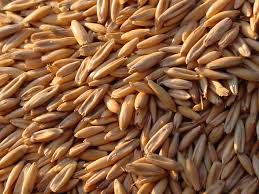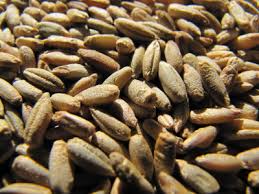Grains Commonly Fed To Horses
Grains are the seeds of cereal plants that belong to the grass family. They are fed primarily as sources of energy. Grains commonly fed to horses are oats, barley, corn, milo, wheat, rice, and rye. These grains can vary widely in energy, protein, fiber, and weight. Differences in nutritional value and physical characteristics should be considered when formulating diets. Not all grains are meant for horses.
Oats
Oat grain is the most popular cereal grain fed to horses. It’s popularity as a grain for horses is due to habit, a lack of familiarity with other grains, and the fact that it is the safest and most palatable to horses. Oat grain has a soft kernel and is easy to chew. Processing oats is not beneficial except for horses with poor teeth or those that are very young. The fiber level of oats is 10-12% and is therefore less likely to cause laminitis or digestive problems as compared to other grains. Oats are an amorphous starch, the most easily digestible of

all the grains. They are broken down in the small intestine and are absorbed long before reaching the caecum. Crystalline starches are difficult to breakdown so starch enters the caecum where it starts to ferment leading to colic, laminitis, founder, etc… Whole oats represent 35 – 45% more body heat production than an equal amount of corn. In the colder snaps of winter weather we recommend feeding the majority portion of your whole oats in the evening feeding which will produce more body heat in the morning (1:00 am to 4:00 am) when it is most needed. If your horses are losing weight given the colder weather, increase your whole oats in the evening feeding.
Barley
Barley grain looks similar to oat grain but is somewhat harder. Therefore, it is generally recommended that barley be crimped or rolled for horses. However, processing does not increase its feeding value for horses with good teeth. The fiber content of barley is higher than that of corn, milo, wheat, rice and rye. Barley is intermediate between oats and corn in energy, fiber level, safety, and heat produced. It is more similar to corn in its density. Slightly less of its starch is digested in the small intestine as compared to corn. Good quality barley is a desirable cereal grain for horses. It can be fed as the only grain in the diet with no adverse effects. However, it is less palatable than oats or corn and is commonly used in a grain mix.

Corn
Corn is commonly fed to horses. However, excessive amounts should be avoided. Corn is slightly less palatable than oats but more palatable than other grains for horses. Corn is prone to mold and lacks the safety margin against over-consumption that oat grain provides. Corn is lower in fiber but higher in energy and density than oats. It provides two times as much energy as an equal volume of oats. When equal amounts of energy (not equal volumes of grain) are fed, corn does not have any greater tendency to obesity or to make a horse “high” than any other grain. Many mistakenly believe that corn is a “heating-feed.” For this reason corn is often fed in the winter and not in the summer. If “hot” refers to high energy, then it is a “hot-feed”; but not when it refers to

high heat production. The reason is that corn is lower in fiber than oats or barley. The greatest amount of heat produced in feed digestion is from microbial fermentation of fiber. Therefore, the higher the fiber content, the more heat produced. In corn only 41% of its gross energy is given off as heat, as compared to 66% of the gross energy in oats. When corn is fed, there is increased risk of cecal acidosis resulting in laminitis, founder, diarrhea, and colic as compared to when oats are fed. The reasons for this are (1) high energy density of corn, (2) risk of excess intake, (3) corn’s lower fiber content, and (4) less starch from corn is digested and absorbed in the small intestine than from oats. Approximately 98% of starch from oat grain is absorbed in the small intestine as compared to 70% of the starch from corn. As a result more starch enters the cecum after the horse eats corn than oats. Starch fermentation in the cecum results in greater production of volatile fatty acids and lactic acid results in disorders noted above.
Milo
Milo has a small hard kernel similar to wheat and must be steam flaked for efficient utilization by the horse. The feeding value of milo is variable depending on the level of tannin present. The tannin content can decrease palatability and protein digestibility. The brown type milo grains are higher in tannin content than are the yellow or red milo grains. Consequently the yellow or red milo grains have a higher nutritional value to horses than do the brown type grains.

Wheat
The wheat kernel is small and hard. It should be cracked, coarsely ground, or steam flaked for efficient utilization by the horse. Fine grinding should be avoided. Wheat is a good feed that can be fed as the only grain without harmful effects. However, because it is less palatable than other grains it more commonly is used with other grains and molasses in grain mix.

Rice
Rough or unpolished rice, the grain before dehulling, is a suitable feed for horses. However, its use is not as popular as is rice bran. The energy content of rice is similar to that of corn on a weight basis. On a volume basis rice is lower in energy than corn but similar to oats. The fiber content of rice grain is slightly lower than that for oats. The protein content of rice is the lowest of all cereal grains.

Rye
Rye is not commonly grown as a feed grain. It is generally used for pasture or hay. The kernels of rye are small and hard similar to those of wheat and milo. Consequently, for efficient utilization they should be cracked by processing. Rye grain is similar in energy, fiber, and feeding value to corn, but is higher in protein. Rye can be fed to horses but should be mixed with other grain and not over one-third of the grain mix should be rye because of its low palatability. Rye should be closely inspected for ergot that is highly toxic to horses.

Digestion of cereal grain starch
Many different cereal grains are fed to horses and they all vary in energy, protein, fat, and fiber content. Oats are very safe for horses because their starch is easily digested and their fiber content is relatively high. Oat grain is rich in amorphous starch. That is why larger amounts of oats can be fed on a daily basis as compared to the other grains with crystalline-structured starch.
Corn and milo contain a high level of crystalline starch that is difficult to breakdown enzymatically. The result is a greater amount of starch entering the cecum that is broken-down by fermentation. A by-product of cecal starch digestion is lactic acid that can give rise to digestive upsets, colic, laminitis, and founder. Cereal grains in order of ease of starch digestion are oat grain, rice, barley, wheat, milo, and corn.

